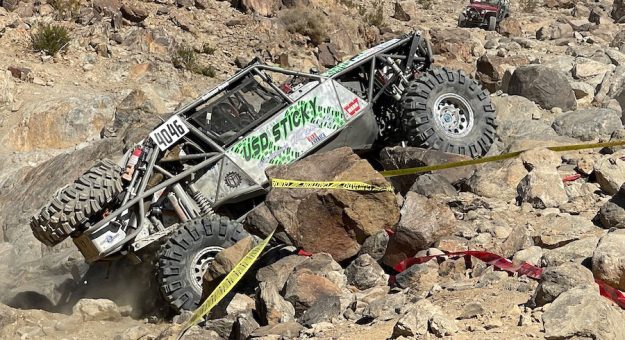King of the Hammers is a race that isn’t meant to be finished. At least, not by the whole field.
The purpose of the gnarly, 200-plus-mile course is to test the endurance of Ultra4 Series drivers and force them to push their vehicles to the limit over the desert and rocky terrain. Last year, only 26 of 102 entrants in the Nitto Race of Kings crossed the finish line. And even then, King of the Hammers co-founder and owner Dave Cole says that was “too many.”
“If it was easy, everyone would do it,” Cole said. “Nothing makes something cooler until you tell somebody they can’t have it.”
There have only been seven “Kings” since the event’s inception in 2007.
Randy Slawson, Shannon Campbell, Loren Healy, Jason Scherer and Erik Miller are all repeat winners, while Josh Blyler and Raul Gomez are recent one-time victors. Though others have come close, the 14-hour race has led to several heartbreaks over the years.
Having a past King of the Hammers triumph has appeared to be the key to claiming another crown, according to Ultra4 USA announcer Miles Hasselquist. Thus, all eyes are often on the reigning Kings who enter. Miller, Campbell, Healy, Blyler and Gomez are among those who will compete for this year’s crown.
“Does it take luck to win this race? Absolutely. But you’re not going to win this race just by luck. You have to put in the time and the effort,” Hasselquist said. “And if you’ve previously won this race, you will always have a chance to win again.”
This year, it’s expected that more than 500 vehicles will enter across the six classes that participate at the 10-day extravaganza — including the Ultra4/4400 Unlimited, 4600 Stock, 4500 Modified, 4800 Legends, 4900 UTV and Electric Vehicle classes.
It’s quite a process for Hammerking Productions to gear up and make ready for the racers to arrive — not to mention the supporting race teams, staff, media personnel and other enthusiasts. About a month before the true racing begins, a group of employees and volunteers assemble in Johnson Valley, Calif., to begin constructing “Hammertown.”

“We build a complete city out in the middle of nowhere,” Hasselquist said. “There’s no water, no electricity when we get there.”
Last year, it took 15 miles of fencing, 1.3 megawatts of electricity and 9,000 gallons of diesel fuel to keep things running smoothly. However, it wasn’t always quite so grand.
“It was 12 guys and a case of beer in 2007,” Cole joked. “This year, it’ll be probably 80,000 spectators.”
Cole has watched the fan excitement, media awareness and driver intrigue grow exponentially over the last five years as King of the Hammers has become the pinnacle event. While he fully expected the experience to resonate within the off-road community, he didn’t foresee the mainstream recognition that has come.
“There are people who are hearing about King of the Hammers today that never heard about it yesterday, and aspire to race in it next year,” Cole noted.
But electing to race at King of the Hammers isn’t something that should be taken lightly. Though it’s always been promoted as an extreme challenge, the competition has greatly intensified over the last decade.
In 2010, the course was 135 miles, nearly half the field finished the race and a winning 4400 class entry cost approximately $100,000. This year, the track will stretch over 200 miles, only 20 percent of entries are expected to cross the finish line and a top-of-the-line trophy truck costs around $500,000.
If everything goes right, the odds aren’t too bad. But that’s not usually the case.
“If you’re going to race King of the Hammers, you’re going to break something,” Hasselquist said.
As a former pit crew member, he is all too familiar with what can go wrong.

First, there’s the weather with which to contend. In the high desert setting, daytime temperatures can reach upward of 70 degrees, while it could easily rain or snow the next night. Second, drivers must expect the unexpected and be prepared to handle whatever issues may arise.
King of the Hammers is a no-chase race — meaning, if a driver isn’t close enough to limp their vehicle to the hot pits, only he or she, their co-driver or a fellow competitor can work on the car.
“It is the hardest, off-road race out there,” Hasselquist commented. “To make a rock crawler go fast, or a desert car go up rocks, it’s the swiss army knife of off-road. It’s one-of-a-kind.”
The start/finish line at King of the Hammers involves a short course that a crew constructs in Hammertown. From there, drivers will face everything from desert whoops to rocks the size of Volkswagens to a dry lakebed.
With the diverse array of terrain and various strategies required to make it to the end, Hasselquist has come to refer to King of the Hammers as a “sprint endurance race.” While it was once all about survival, it’s now equally about speed. In the desert stretches, competitors can reach up to 140 mph. But in the technical rock sections, they slow to nearly 1 mph to crawl up the steep landscape.
The racer who can preserve their tires, suspension and spirit is often the one who will prevail.
A win at King of the Hammers may be on the bucket list for most drivers, but for some, the reward of making it to the finish line is enough. When the long grind comes to an end, the feedback Cole hears from most racers is “thanks for the challenge.”
“There’s not a lot of challenges left in the world,” Cole added. “This is different.”
This year’s edition of the 10-day desert and rock crawling festival begins Feb. 2.
This story appeared in the Jan. 25 edition of the SPEED SPORT Insider.

